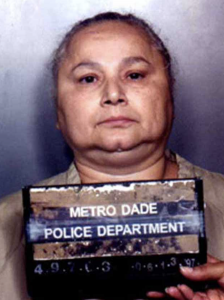Who Are the Most Dangerous Female Cartel Bosses?
The world of organized crime is often associated with male leaders and bosses. However, there are a few female cartel bosses who have made a name for themselves in this dangerous and ruthless industry.
These women have proven themselves to be just as cunning and ruthless as their male counterparts, and they have earned the respect and fear of those around them.
From Griselda Blanco to Enedina Arellano Félix, these female bosses have made a significant impact on the world of drug trafficking and organized crime.
In this article, we will explore the most dangerous female cartel bosses and their rise to power, as well as their tactics and methods of operation.
#1. Griselda Blanco

Griselda Blanco was not only a ruthless cartel boss but also a pioneer in the world of drug trafficking. She is often referred to as the “Godmother of Cocaine” due to her significant role in the Medellin Cartel, one of the most powerful drug cartels in history.
Blanco was born in Cartagena, Colombia, in 1943 and began her career in organized crime as a child, stealing and selling items to make ends meet.
In the 1970s, Blanco moved to the United States, where she continued her involvement in drug trafficking.
She quickly gained a reputation for her brutal tactics, which included ordering the murders of anyone who crossed her. Blanco was known for her cold-bloodedness and her ability to eliminate anyone who posed a threat to her or her business.
She was involved in various illegal activities, including drug trafficking, money laundering, and murder.
Despite her success, Blanco’s reign came to an end in 1985 when she was arrested in California. She was charged with multiple drug-related offenses, including trafficking cocaine into the United States. Blanco was eventually sentenced to 20 years in prison, but her involvement in organized crime did not end there.
While in prison, she continued to operate her drug empire through her son, Michael Corleone Blanco.
Griselda Blanco’s legacy as a powerful and dangerous female cartel boss has had a lasting impact on the world of organized crime.
She proved that women could be just as ruthless and successful as men in this industry, and her tactics and methods of operation have influenced many other female cartel bosses who followed in her footsteps.
Despite her eventual capture and imprisonment, Blanco’s name remains synonymous with drug trafficking and organized crime, and she continues to be a fascinating and controversial figure in the world of true crime.
#2. Sandra Ávila Beltrán

Sandra Ávila Beltrán, also known as the “Queen of the Pacific,” was one of the most prominent female cartel bosses in Mexico.
Born in Baja California in 1960, Ávila Beltrán was a key figure in the Sinaloa Cartel, one of the largest and most powerful drug trafficking organizations in the world.
Ávila Beltrán was known for her business acumen and her ability to evade law enforcement. She was involved in various aspects of the drug trade, including trafficking, money laundering, and bribery. She was also known for her luxury lifestyle, often flaunting her wealth and expensive possessions.
Despite her success, Ávila Beltrán’s luck eventually ran out. In 2007, she was arrested by Mexican authorities in connection to a large-scale drug trafficking operation.
She was eventually extradited to the United States in 2012, where she was charged with conspiracy to traffic cocaine. Ávila Beltrán pleaded guilty to the charges and was sentenced to 70 months in prison.
Ávila Beltrán’s arrest was a significant blow to the Sinaloa Cartel, which had relied heavily on her expertise and connections. However, her influence and legacy have continued to inspire other female cartel bosses, who have sought to follow in her footsteps.
Despite her involvement in the drug trade, Ávila Beltrán has been something of a cultural icon in Mexico, with numerous songs and books written about her life and exploits.
Her nickname, the “Queen of the Pacific,” has become synonymous with power, wealth, and danger, and she remains a fascinating figure in the world of organized crime.
#3. Maria Jimenez Rodriguez

Maria Jimenez Rodriguez, also known as “La Tosca,” was a feared female cartel boss and a key leader in the Gulf Cartel, one of the largest and most powerful drug trafficking organizations in Mexico.
Rodriguez was known for her involvement in various criminal activities, including drug trafficking, extortion, and kidnapping.
Rodriguez’s nickname, “La Tosca,” referred to her tough and ruthless personality. She was not afraid to use violence to eliminate any potential threats to her power or to protect her business interests.
Her tactics included kidnapping and extortion, which she used to maintain control over various territories and business ventures.
Despite her success, Rodriguez’s criminal career eventually came to an end. In 2011, she was arrested by Mexican authorities in connection to various criminal offenses, including drug trafficking and money laundering.
Rodriguez was eventually sentenced to 43 years in prison, where she remains to this day.
Rodriguez’s arrest was a significant victory for law enforcement, as she was one of the most powerful female cartel bosses in Mexico at the time. However, her influence and legacy continue to inspire other female cartel bosses, who have sought to fill the void left by her arrest.
Maria Jimenez Rodriguez’s life and career highlight the dangerous and brutal nature of the world of organized crime.
Despite the risks and the threat of imprisonment, many individuals, including women, are drawn to this industry by the promise of wealth and power.
While Rodriguez’s reign as a cartel boss may be over, her legacy and influence on the world of organized crime will continue to be felt for years to come.
#4. Enedina Arellano Félix

Enedina Arellano Félix is a notorious figure in the world of drug trafficking and organized crime.
She was a member of the Arellano Félix Cartel, one of the most powerful drug trafficking organizations in Mexico, and was the sister of several of the cartel’s leaders.
Arellano Félix was known for her involvement in money laundering and drug trafficking, and she was considered to be one of the most dangerous female cartel bosses in the world.
Despite being a key member of the Arellano Félix Cartel, Arellano Félix managed to evade law enforcement for years. She used her connections and her skills in money laundering to stay one step ahead of authorities. She was also known for her cunning and her ability to manipulate those around her.
However, in recent years, Arellano Félix’s luck has run out. In 2007, she was arrested by Mexican authorities in connection to various criminal offenses, including drug trafficking and money laundering. However, due to lack of evidence, she was released from custody.
Despite the arrest, Arellano Félix remained a major player in the world of organized crime.
She continued to operate her drug empire from behind the scenes and managed to evade law enforcement for years. As of now, Arellano Félix remains at large and is still considered to be one of the most dangerous female cartel bosses in the world.
Arellano Félix’s life and career highlight the dangerous and ruthless nature of the world of organized crime.
Despite the risks and the threat of imprisonment, many individuals, including women, are drawn to this industry by the promise of wealth and power.
While Arellano Félix may still be at large, law enforcement agencies around the world continue to work tirelessly to bring her and other dangerous cartel bosses to justice.
How Do Female Cartel Bosses Operate?
Female cartel bosses often use their gender to their advantage, as they are less likely to draw attention from law enforcement. They are also known for their ability to use their charm and manipulation skills to get what they want.
Many female cartel bosses have been involved in the drug trade since a young age, often starting out as couriers or drug mules. They work their way up the ranks through loyalty and ruthlessness, often using violence to eliminate any potential threats.
Why Are Female Cartel Bosses So Dangerous?
Female cartel bosses are just as dangerous as their male counterparts, if not more so.
They are often underestimated by law enforcement, which gives them a strategic advantage. They are also known for their cunning and their ability to manipulate those around them.
Female cartel bosses are often more ruthless than male bosses, as they have more to prove in a male-dominated industry. They are not afraid to use violence to maintain their power and eliminate any potential threats.
Conclusion
In conclusion, female cartel bosses are a force to be reckoned with in the world of organized crime. From Griselda Blanco to Enedina Arellano Félix, these women have proven themselves to be just as dangerous and ruthless as their male counterparts.
They use their gender to their advantage and are skilled manipulators and strategists.
Law enforcement agencies must be vigilant in their efforts to track down and bring these female bosses to justice.
FAQs
-
Are female cartel bosses common?
No, female cartel bosses are not common, but they do exist.
-
How do female cartel bosses rise to power?
Female cartel bosses often start out as couriers or drug mules and work their way up the ranks through loyalty and ruthlessness.
-
Are female cartel bosses more dangerous than male bosses?
Female cartel bosses can be just as dangerous as male bosses, if not more so.
-
Why are female cartel bosses often overlooked?
Female cartel bosses are often overlooked because the world of organized crime is still heavily male-dominated. Law enforcement agencies are more focused on male cartel leaders, making it easier for female bosses to operate under the radar.
-
Are female cartel bosses involved in all aspects of drug trafficking?
Yes, female cartel bosses are involved in all aspects of drug trafficking, from production to distribution.
-
How do female cartel bosses avoid being caught by law enforcement?
Female cartel bosses often use their gender to their advantage, as they are less likely to draw attention from law enforcement. They also use sophisticated methods to avoid detection, such as encrypted communication and secret codes.
- How are female cartel bosses viewed within their organizations?
Female cartel bosses are viewed with respect and fear within their organizations. They are often more ruthless than male bosses and are not afraid to use violence to maintain their power.
Fact Check
We strive to provide the latest valuable information for our readers with accuracy and fairness.
If you would like to add to this post or advertise with us, don’t hesitate to contact us. If you see something that doesn’t look right, contact us!





